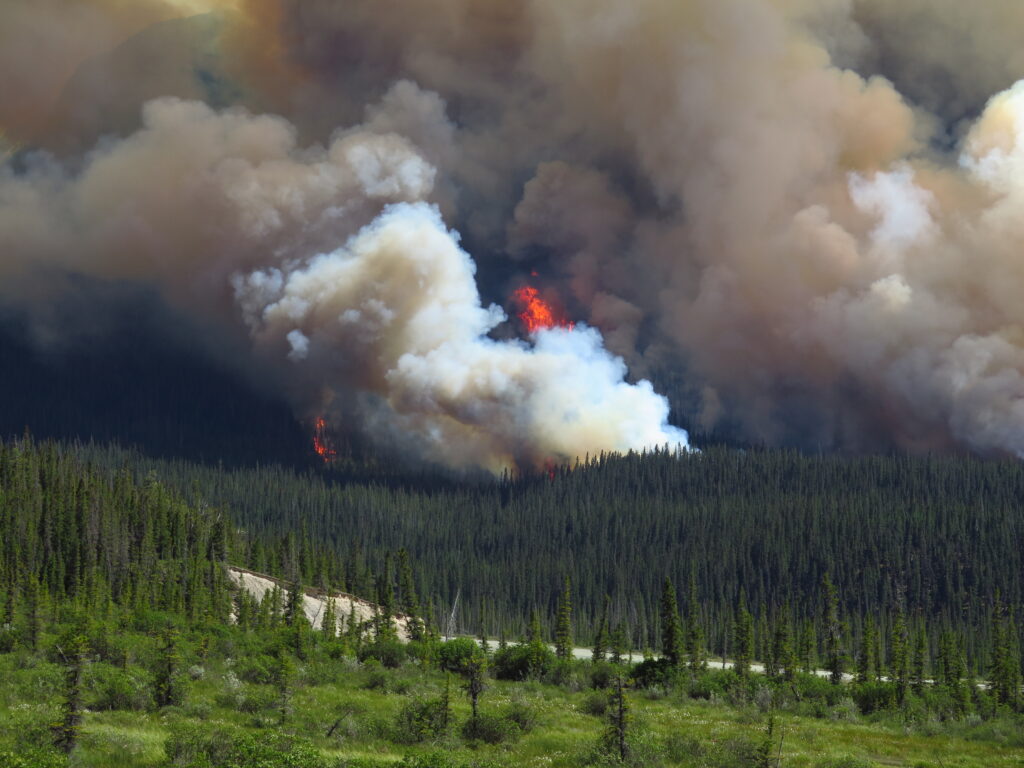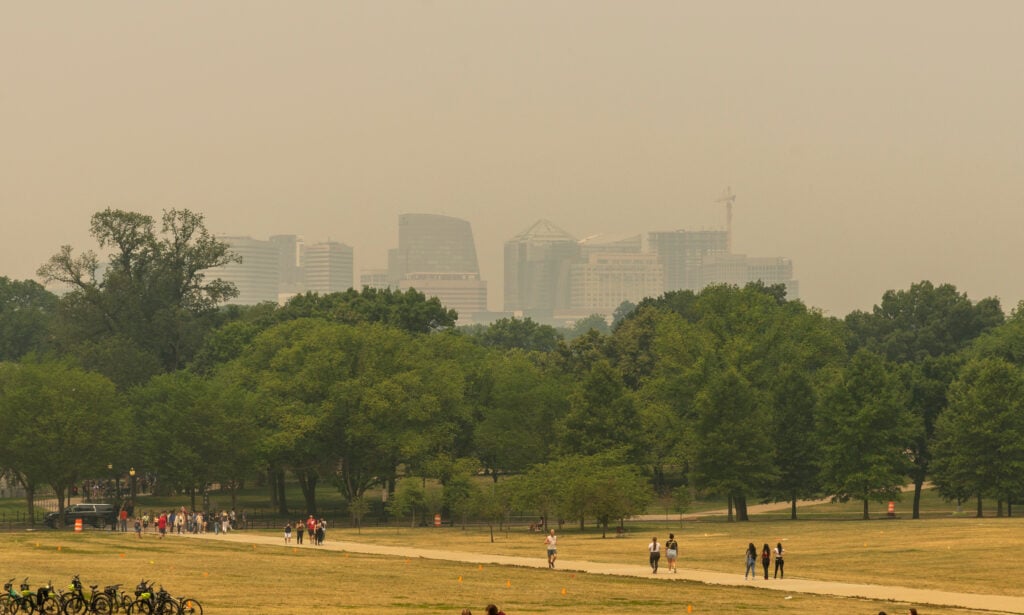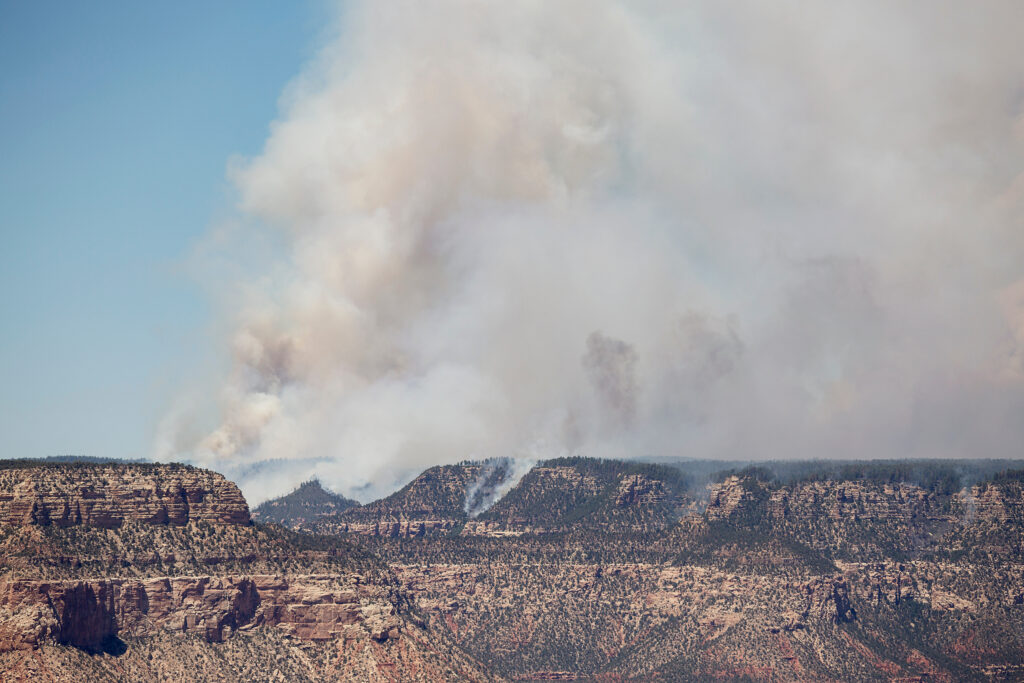The Global Reach & Rising Risk of Extreme Wildfires
POW Science Alliance member Neil Lareau, a professor of Atmospheric Science at the University of Nevada, Reno, who studies extreme fire behavior, noticed something unusual about this year’s Tour de France. As riders ascended the early stages, the sky appeared unseasonably hazy. He realized the haze was likely smoke from wildfires in Canada, which had become so large that the smoke was impacting athletes on other continents.
“Extreme fires inject it [smoke] higher in the atmosphere so it will travel farther,” he says. “Once it’s up in the jet stream, it can travel around the globe.”
This summer, like so many in recent memory, we’re feeling the global impacts of increasingly active and intense fire seasons. Those Canadian fires, which began in April in the northern boreal forest, have already burned an area the size of New Brunswick, sending smoke across oceans. Some have even overwintered, a phenomenon Lareau calls “zombie fires,” where they never fully die out.

These are also more extreme fires that create their own weather pattern, such as pyrocumulonimbus clouds, which can propel smoke high into the atmosphere. “The more fires we have on the landscape, the more chances there are for those extreme events, which are destructive and dangerous,” he says.
That same smoke has at times drifted thousands of miles south, blanketing much of the Northeast and Midwest. What was once a rare occurrence is becoming increasingly common. “Everyone in the Northeast is kind of shellshocked that there’s now a smoke season in places that are remote from the fires themselves,” Lareau says.

Canada’s fires aren’t an isolated story; they’re part of a larger pattern. Across the U.S., wildfire seasons are stretching longer and burning hotter. In the U.S., the Southwest has seen extreme fire conditions. A hot, windy set of months after a dry winter has created dry tinderbox fuels. That’s led to major blazes like the Dragon Bravo, which started July 4th on the north rim of the Grand Canyon, and has become one of Arizona’s biggest fires at over 145,000 acres, and the Lee Fire in Colorado, which is already one of the state’s biggest, and the 5th largest in Colorado history.

In contrast, Lareau says some regions of the U.S. that are traditionally fire-prone, like Montana, Oregon, and his home in the Sierra Mountains of California, have had slower than usual starts to fire season this year. But he warns things could change quickly with long-range forecasts staying hot and dry.
There is widespread evidence that fire season is lengthening in fire-prone regions. “No matter how you measure it, there’s an increase in the number of days conducive to extreme fire going up globally and then really going up in areas that are already fire-prone.” He says they’ve found observational evidence for a doubling of the number of extreme fire events over the past 25 years. So if it seems like fires are more frequent and more destructive, it’s true.
Lareau says the six most intense years of fire activity have all been since 2017, and that there’s been an 8-fold increase in area of high intensity burn in the western U.S. “These are the extreme fires that have really negative effects for landscape. There’s not a whole lot of good coming out of these fires,” he says. Some fires are good and natural; they’re necessary to keep ecosystems healthy and regenerating. But these intense fires we’re seeing are scorching landscapes beyond repair, and they’re also causing losses to human life and infrastructure, like the fires that ripped through the Los Angeles area in January or the Dragon Bravo that decimated the Grand Canyon Lodge on the North Rim.
“It is tough emotionally year after year. We’re taking a lot of hits,” he says. “It’s scary and it should be scary and it mandates a lot of attention.”
The danger doesn’t end when the flames die down. Smoke can harm people not just in the fire’s shadow, but thousands of miles away as it rides the jet stream. As far as health impacts go, we know that small particulates can enter our circulatory systems when we breathe smoky air. That has direct impacts on our cardiovascular and respiratory health, particularly in vulnerable populations. But the really scary thing is that there’s still a lot unknown about exactly how bad that smoke inhalation can be, especially when extreme fires burn through urban areas, where they’re burning structures with unknown contents, instead of just plant material. “There was significant lead loading in some of the smoke from the Eden Fire in particular, because it was burning older structures with leaded paints,” Lareau says.
So what do we do to prepare for fires, mitigate their impacts, and try to reduce our risk in the future?
Lareau says the most immediate steps you can take start at home. Make sure your house has air filtration, and mitigate your exposure on days with a high AQI. That might mean skipping the trail run or bike ride when the air quality tanks. Your lungs will thank you later.

Then, he says we can start thinking at the community level, by reducing fuels and doing prescribed management through things like controlled burns. Many communities in fire-prone places are starting to do that, to reduce their risks ahead of time. But he says it can be socially tricky because it usually takes some amount of preemptive burning and introducing fire to the landscape.
“Smoke has all these negative human health consequences, but we also need to be willing to tolerate some good fire on the landscape, and not freak out when we have smoke in our communities from prescribed fire,” he says. “I’d rather have it under control and know when you can plan around it. We need to be using fire in a good way when those opportunities present themselves.”
Lareau also says that the most impactful thing we can do—and that we need to do—for the future is to stop burning carbon dioxide. If we want to reduce the risk of extreme fires, we need large-scale political action along with personal action. “Smoke impacts are a direct manifestation of warming trends on Earth that come from burning carbon dioxide,” he says. “There is a direct line between threats posed by carbon dioxide and human health. It’s an important thing for people to understand and support politically. We need to regulate these emissions.”
The takeaway: protect your lungs today, protect our climate tomorrow. Both matter, and both are in our hands.
Thanks to our POW Brand Alliance partner Keen for supporting this post:


Author: Heather Hansman
Heather Hansman is an award-winning environmental journalist who writes about the ways people, places, and recreation all influence each other. She’s the author of Powder Days: ski bums, ski towns, and the future of chasing snow, which looks at—among other things—how climate change impacts skiing. She thinks about the rest of the water cycle, too, she’s […]
